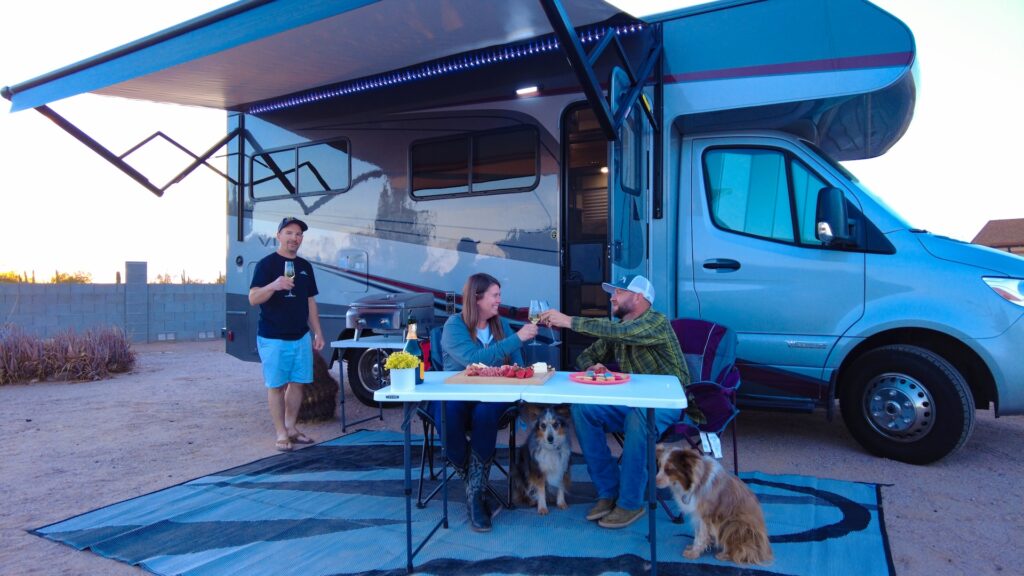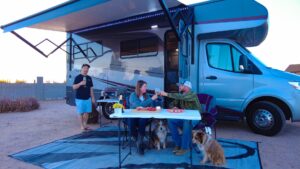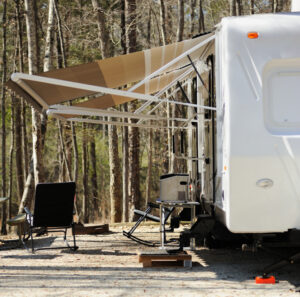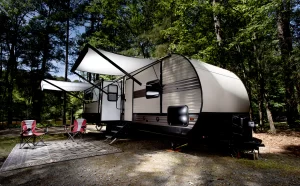You’ve pulled into a prime camping spot in your beloved RV and are looking forward to spending some relaxing time in the wilderness. Your space is sunny and bright and perfect. Only one problem—your RV awning isn’t working.
But don’t despair! We’re going to look at the different ways your power awning may malfunction and how to figure out where the problems are. From DIY to a trip to the RV repair shop, we’ll have you made in the shade once again.
How Does an RV Awning Go Wrong?
If you’re new to RV life you may be wondering how your awning might malfunction. There are three primary causes of awning problems:
- Power disruptions
- Motor failure
- Mechanical failures
Let’s troubleshoot all three (for awning fabric repair, check out this article) But first, a few reminders.
We’re talking about power awnings today, and that means motors and electricity. Faulty wiring and other electrical problems can cause fires and injuries if proper precautions are not taken during inspection and repair.
You don’t have to DIY anything electrical if you’re unfamiliar or uncomfortable doing so. You’ll be safer and sleep better if you have a professional RV repair technician do the job.
Your awnings can malfunction in a variety of ways. They may be noisy or crooked or refuse to open or close partially or completely. That last one is the biggie.
It’s easier to have an awning stuck closed than to have it stuck open. You’re free to drive your vehicle to the nearest RV repair shop right away. You cannot drive your RV with the awning open even a little bit.
Because motorized awnings do wear out and have other issues, learn how to operate them manually before you take your first RV trip. That way a malfunctioning awning doesn’t have to ruin a perfectly good vacation. It’s good for your peace of mind and for your wallet (avoiding emergency service in the wilderness is always good for your wallet).
But let’s check a couple of simple things before you give up on those wonderful, shade-giving, rain-protecting awnings.
If your awning will not extend or retract, do the easy (and cheap) things first:
- Has your awning been recalled? This is not unusual and if it is the case, bring it to the RV repair shop and have it fixed for free.
- Check the fuse panel. Sometimes you just trip a breaker or blow a fuse. If you hear no sound at all when you try to extend the awning, this is a common culprit.
These are quick and easy and don’t require any particular expertise. If you aren’t familiar with the fuse panel, take a look in your owner’s manual for a guide.
Check Your Power
If your motorized awning has not been recalled and the fuse panel is fine, it’s time to check your power. First, check your RV batteries. If your awning is one of the first things you use, its failure may be the sign of a low battery or a malfunctioning converter.
If your RV has a built-in battery meter, excellent! If not, use a volt meter. Unplug from shore power and try the awning with the voltmeter on the battery. If you see a big dip, you have a battery problem.
If the main batteries check out fine, you’ll need to dig a little deeper. It’s time to look at the wiring and the power to the awning itself.
This is where new users, unfamiliar with RV electrical systems, should consult a professional. A malfunctioning awning is not worth an electrical fire or an injury. If you’re confident in your electrical DIY skills, let’s get to it!
First, access the awning motor. Since your awning won’t extend, you’ll need to open it a little bit manually.
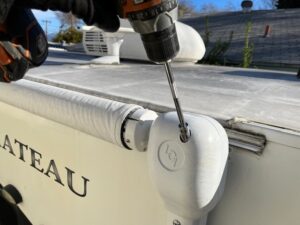
How you access your awning motor will vary depending on your vehicle. Do your homework before you get on the ladder. You’ll need to open the awning far enough to access the wiring. On many coaches, you’ll be able to open the awning simply by turning the open/close bolt with a drill and socket.
Once the awning is open, it’s time to expose and check the wires from the coach to the awning. You’ll find them in the trough running down the side of your motorhome or travel trailer from the motor.
Turn off the power before you disconnect the wires from the vehicle from the wires for the awning. Don’t mess with live wires.
You’re going to check the wiring here in two ways. Once they’re separated, use your volt meter to make sure you’re getting 12 volts from inside.
Next, take a good long look at the awning wires. Check for cracked insulation and any other signs of wear or fraying. If you see any outward sign of damage, it’s time to see a professional for replacement wires.
If everything looks intact, connect the awning wires to a portable battery. If the awning works, the problem may be in the connection between the coach and the awning.
If the awning does not work, the problem is in the wiring in the awning arms or with the switch or motor. Head up to the motor and find the motor wiring quick-connect. Test with your volt meter when the switch is depressed. If you get +/- 12 volts from the switch, the wiring is not the issue. Your problem is the motor.
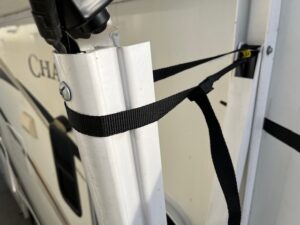
IMPORTANT: Before removing your faulty motor, take the time to lash down the awning arms on both sides. Once the old motor is removed and disengaged from the gearing, the awning arms will extend out quickly. Use straps to prevent this from happening. Not taking this important precaution could cause you to fall off your ladder.
If faulty wiring is the issue, you’ll need to decide based on your own skill level how to proceed. Most owners should have a professional do electrical wiring repair and replacement.
Check Your Motor
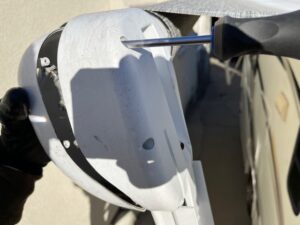
Now it’s time to connect the motor directly to a portable battery. Open the motor casing and check for any visible corrosion or damage to the wires. If you see any, stop here. Take your rig to the shop.
If the wiring passes your visual inspection, access the leads from the motor and attach them correctly to your battery. Do not do this unless you have experience with electrical systems.
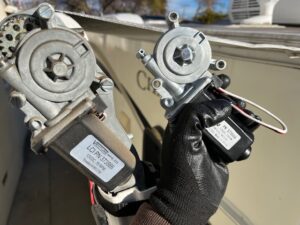
If the motor does not respond, it very likely needs to be replaced. You can replace an awning motor yourself, but most of you should take the vehicle to an RV repair shop. This is a DIY project only for experienced RV fixer-uppers.
Check Your Mechanicals
Mechanical issues cover a lot of ground. Everything from a crooked awning that needs to be reloaded to a noisy bracket or loose awning chord screw can cause problems. Broken bearings and gears can defeat even the manual override and leave you with an awning that won’t budge.
The best way to avoid mechanical problems when you’re on an RV trip is to have a good, regular maintenance schedule. Your RV repair shop will catch these issues before they derail your vacation.
The mechanical parts of your RV awning are just as susceptible to wear as the wiring and motor. No matter how well an awning is built, use, time, and exposure to the elements will make repairs and replacement parts necessary.
If you’re an RV repair DIY enthusiast, check out our Leisure Coachworks Parts Store for hardware, cords, lighting, locks, electrical supplies, and much more.
Learn more about mechanical issues as well as repairing awning fabric over at our article about repairing and replacing RV awnings.
RV Repair by Professionals
Is your head spinning from all that information? We’ve said it before, but it bears repeating:
You do not have to DIY your RV repairs!
A motorhome or travel trailer is a complicated piece of machinery. Combining elements of a house and a car leads to a lot of moving parts. For some of you, this is a fun challenge and you love learning about every system.
Others want to enjoy their coach with no strings attached, and that’s okay, too. As long as you learn how to safely operate your vehicle and all of its amenities, you can let a professional handle the maintenance and repairs.
A full-service RV repair shop like Leisure Coachworks can quickly and safely diagnose and repair a malfunctioning power awning. As long as you know how to operate the awning manually, you can enjoy your vacation and take your rig into the shop when you get home.
Power RV awnings are fantastic, but they are a little prone to malfunctioning. It’s smart to have a plan for what you’ll do if they won’t work, sound bad, or just wear out. Contact us today at Leisure Coachworks and we’ll help you create a regular maintenance schedule to reduce the chance of any breakdowns when you’re out living your best RV life.
